by Claudia and Conrad.
On Sunday we guided a walk for the New York Flora Association along the South Taconic Trail. This post shares some of the botanical and entomological highlights, including two orchids, several species in the heath family (Ericaceae), and a scattering of insects. If you would like to see habitat images and directions/a trail map, you can check out our blog post from an outing on 7 June 2015: https://hvfarmscape.wordpress.com/?s=sunset+rock
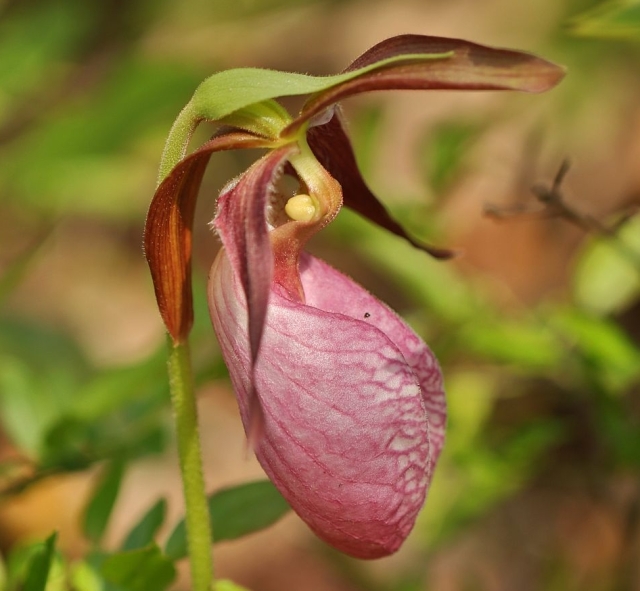
Last weekend, one could not overlook the Pink Lady’s Slippers (Cypripedium acaule) which had started to bloom along the trail.
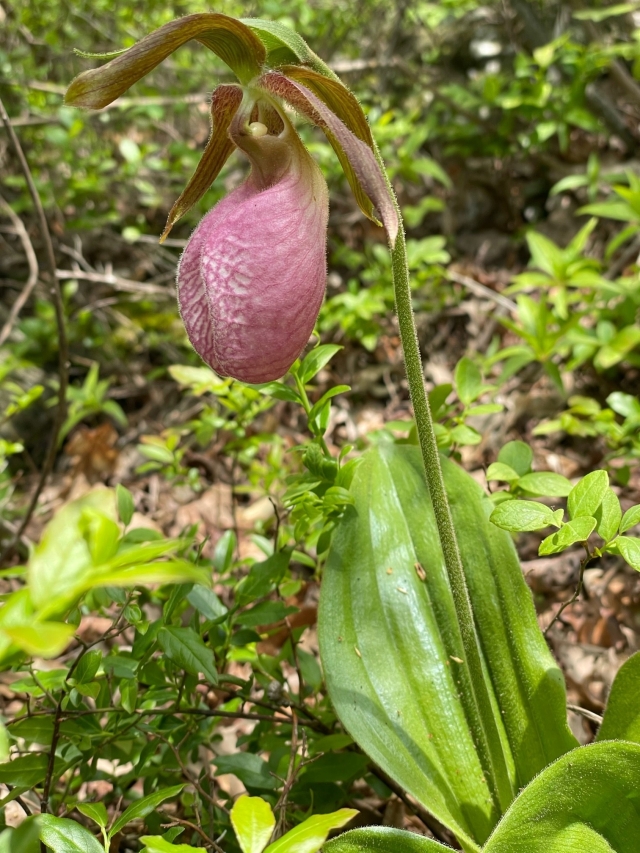
Although many of the 30 native orchids known to occur (or have occurred) in Columbia County are rare in our landscape and/or grow in very specific habitats, Pink Lady’s Slippers can still be encountered here and there in undisturbed sites and might well be the best known of our orchids. Its single, pouch-like flower crowns a leafless stalk, which emerges from a cluster of hairy basal leaves. Thanks to John Meierhoffer for this beautiful image.
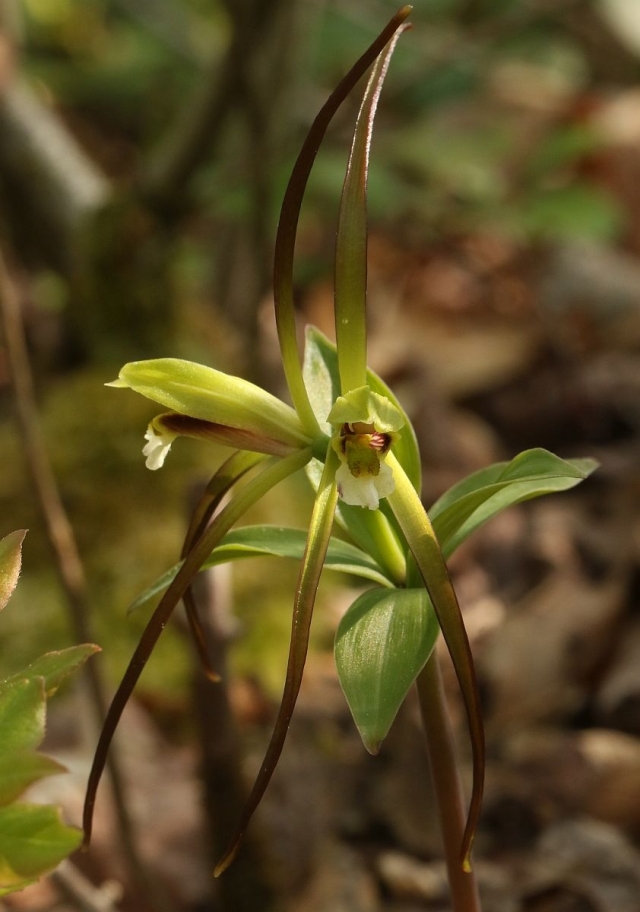
However, we really got excited when we found several small patches of a much rarer orchid, the Large Whorled Pogonia (Isotria verticillata). It usually has one flower that is displayed above a whorl of shiny, hairless leaves. But the plant in this image had two flowers, each adorned with three long, narrow, purple-brown sepals.

This image shows two Large Whorled Pogonia plants whose flowers are about to open, and a dried seed pod left over from last year. We know this easily overlooked botanical jewel only from three locations in Columbia County, all in Taconic State Park. If you ever come across any orchids, PLEASE do not even think about picking them or digging them up! But we would love to see your photos and learn about additional locations where they occur in our county.
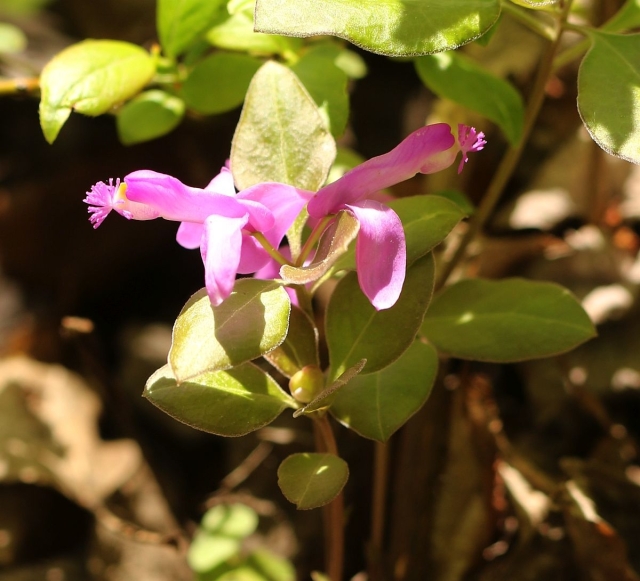
Almost orchid-like are the flowers of Gaywings or Fringed Polygala (Polygala paucifolia), which are composed of five sepals (two of which create the “wings”) and three petals (one of which is boat-shaped with a fringed tip). The leaves of these small perennial plants (they are usually no taller than a few inches) stay green through the winter. New leaves emerge in early spring and the new branches also bring forth these delightful flowers. In addition to the insect-pollinated flowers that draw our attention, Gaywings also have self-pollinating flowers that remain in the ground (a strategy this species has in common with violets).
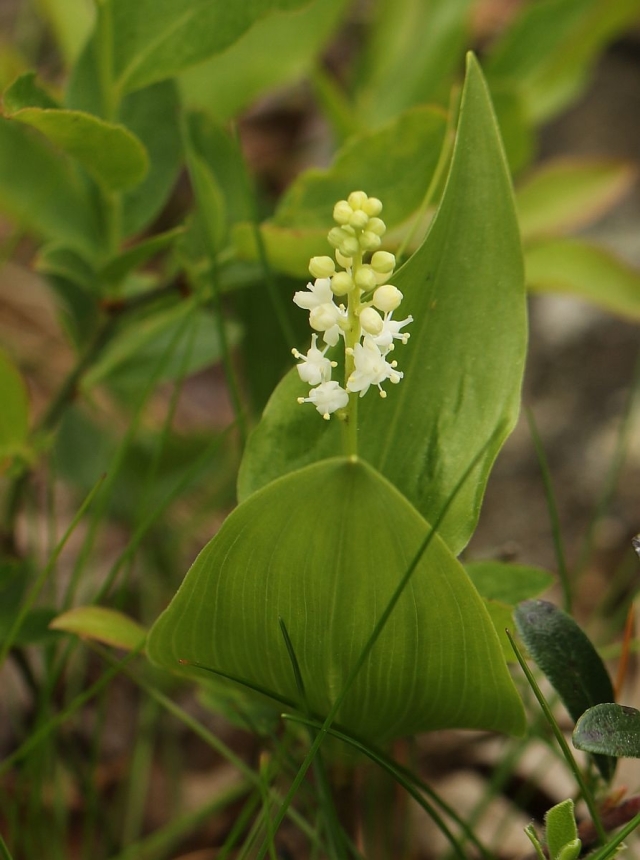
No walk through a dry woodland in May would be complete without Canada Mayflower (Maianthemum canadense), which forms large, rhizomatous colonies under oak and pine trees. Most of the plants in each colony consist of a single leaf and don’t bear flowers. The racemes of tiny 4-parted flowers (an exception in this plant group, which usually has 3 or 6 flower parts) only develop on two-leaved plants.
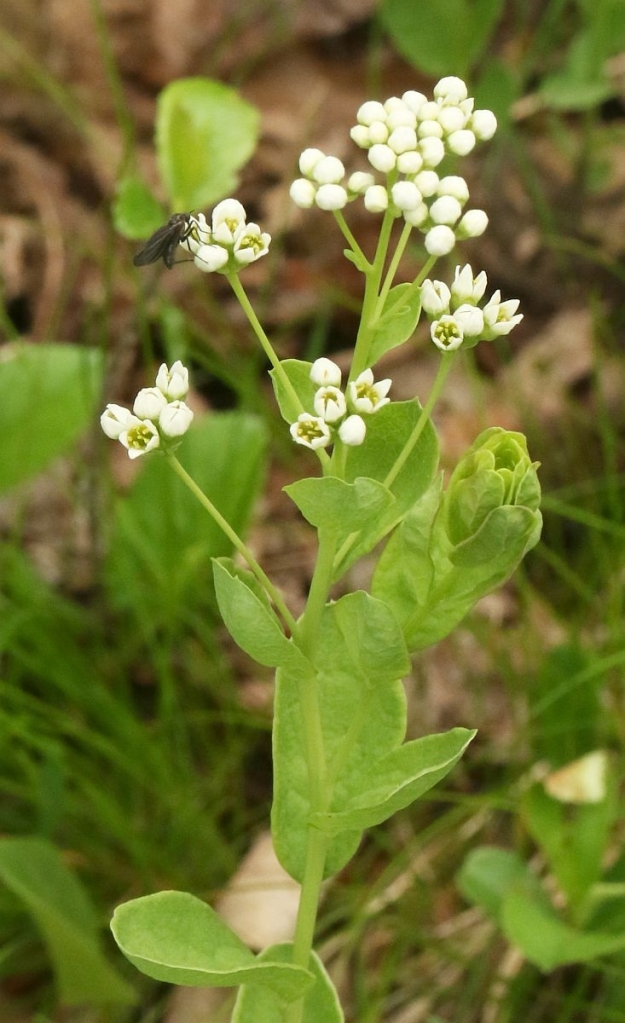
Bastard Toadflax (Comandra umbellata) is a hemiparasite, which is a plant that photosynthesizes, but also parasitizes the roots of other plants to steal nutrients. In our region, it seems to almost always grow near blueberries (Vaccinium sp.) and is most common near rock outcrops on the Taconic Ridge. (If we ever create a rock band, we will name it after this plant.)
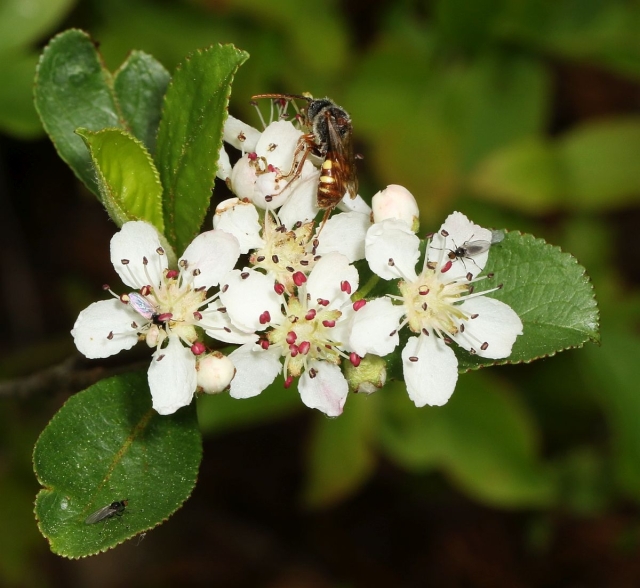
One of the most common, hip-high shrubs along the Taconic Ridge is Black Chokeberry (Aronia melanocarpa), a member of the Rose family. Its early flowers are an attraction to a variety of pollinators, including this cuckoo bee (Nomada sp.), which is a nest parasite of other bees.
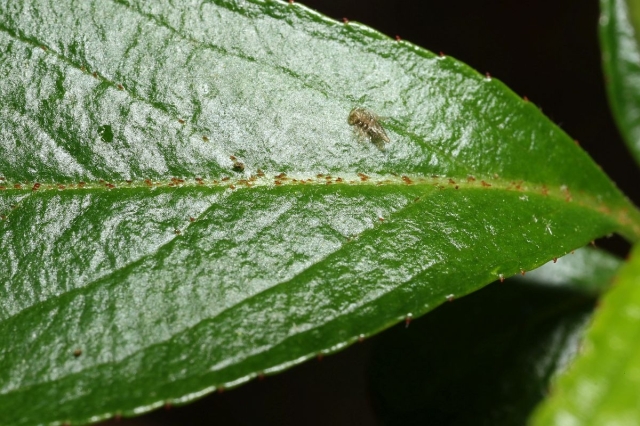
Even without flowers, Black Chokeberry is easily recognized by its unique glands along the midrib of the leaves.
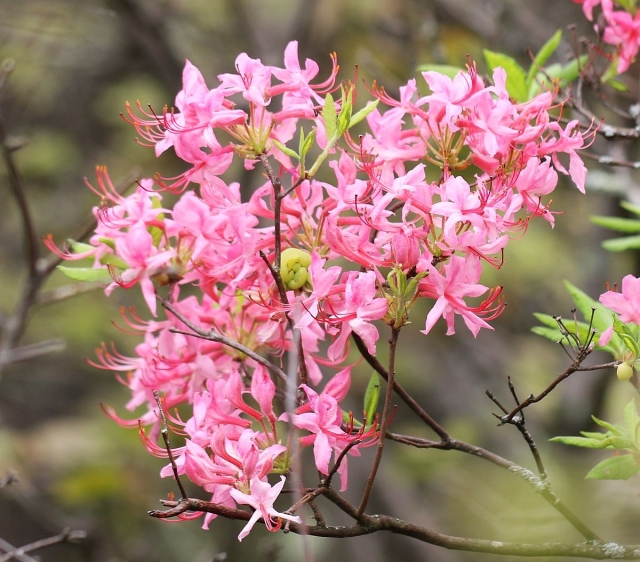
Early Azalea (Rhododenrdon prinophyllum) is a taller shrub that just opened its fragrant flowers during the last week. It is one of the members in the heath family (Ericaceae), which grow in the dry acidic soils along the Taconic Ridge.

A closer look at the flower stalk and corolla tube of Early Azalea reveals that it is covered with two kinds of hairs: fine, simple hairs that bend every which way, as well as stubby, straight, glandular hairs. The glands are visible as tiny “balls” at the tip of these hairs. The similar Pink or Pinxterbloom Azalea (R. periclymenoides) lacks these glandular hairs. In addition, its leaves are less hairy than those of Early Azalea.
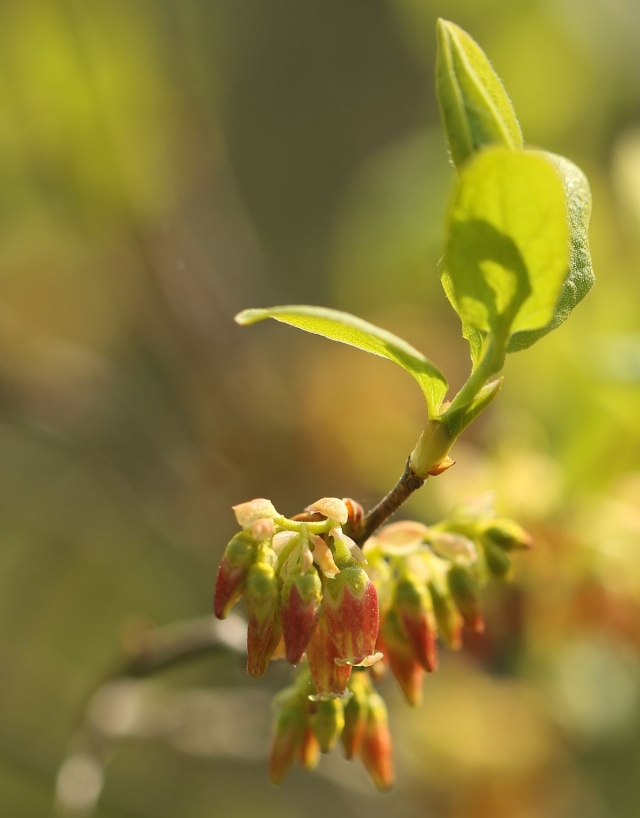
Black Huckleberry (Gaylussacia baccata) is another very common member of the heath family in this habitat. It is a colonial shrub that grows knee- to hip-high and has racemes of tightly-clustered, urn-shaped flowers that turn from green-pinkish to white as they mature.

A closer look reveals yellow gland dots on the flowers, young stems, and leaves of Black Huckleberry. (The edible berries, which will ripen in June, lack these glands.)

The leaves of Black Huckleberry are sticky to the touch and their undersides sparkle in the sun. This makes this species easy to distinguish from blueberries (Vaccinium spp.), who lack the yellow glands.
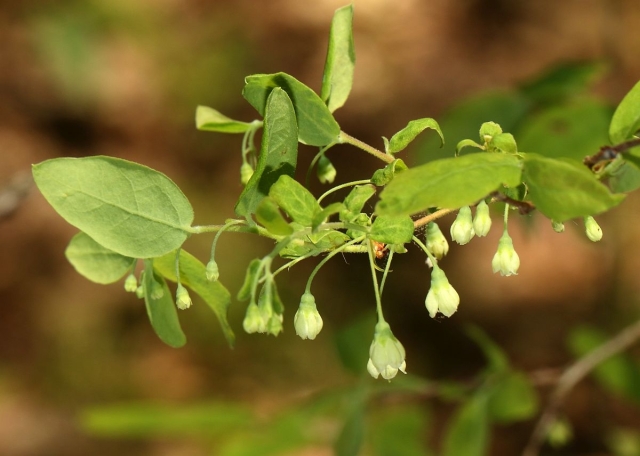
Deerberry (Vaccinium stamineum) is one of the taller blueberries on the Ridge. It has bell-shaped (rather than tubular or urn-shaped) flowers (the ones in the image are not quite open, yet—their petals will grow bigger and spread out more…), each with a long peduncle. It is easy to recognize when in flower or fruit (the fruits also have long stalks and are not particularly tasty), but in their absence can be confused with Highbush Blueberry (V. corymbosum; which we did not find near Sunset Rock, but often see in swamps and sometimes in oak forest).
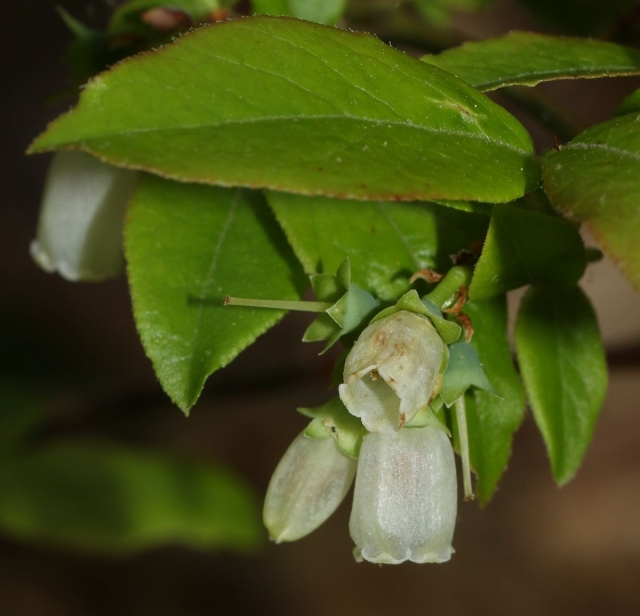
Common (or Early) Lowbush Blueberry (Vaccinium angustifolium) is probably the most common, low-growing blueberry that can form large colonies. Its leaves tend to be shiny and have a similar color on their upper and lower side. They can be glabrous or somewhat hairy. The margins of the leaves tend to be finely serrated and the leaves often have pointed tips.

Hillside (or Late) Lowbush Blueberry (Vaccinium pallidum) often occurs together with Common Lowbush Blueberry. It sometimes grows a little taller, and its leaves tend to be matte, with a glaucous (dull grayish-green) underside, no hairs, and mostly entire (non-serrated) margins. Often (though not always), the leaves are broader and more rounded at the tip than those of Common Lowbush Blueberry.
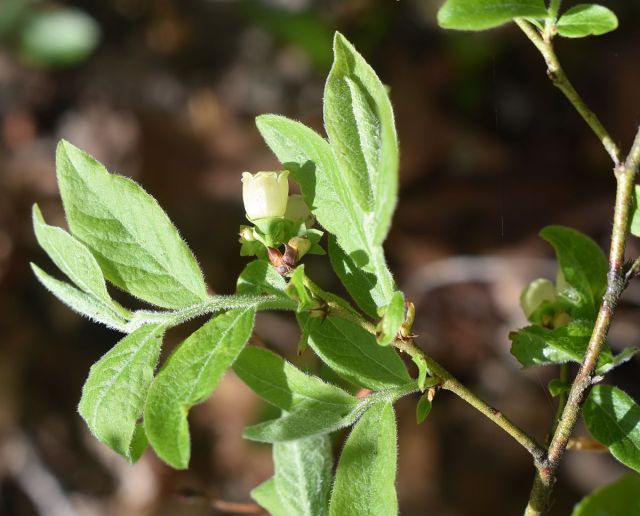
The rarest of the lowbush blueberries is Velvet-leaf Blueberry (Vaccinium myrtilloides), which has a dense cover of fine hairs on its leaves and young stems. It seems to be confined to the higher elevations in our County.
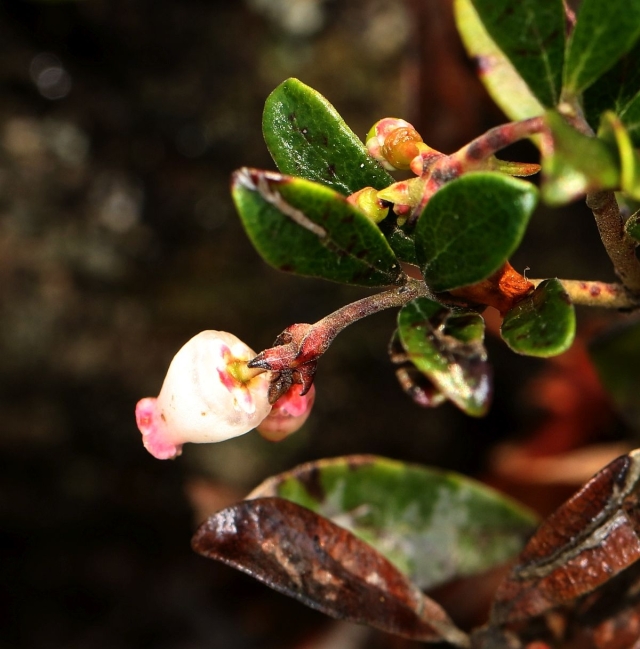
Another member of the Ericaceae family is Bearberry or Kinnikinnick (Arcostaphylos uva-ursi), an evergreen, very low, colonial shrub that forms carpets around the rock outcrops on the Taconic Ridge. Unlike the sweet and juicy blueberries, which are quickly eaten up by all sorts of animals (and people), the tougher and drier berries of this species tend to stick around for a long time, and are sometimes referred to as “emergency food” for wildlife.
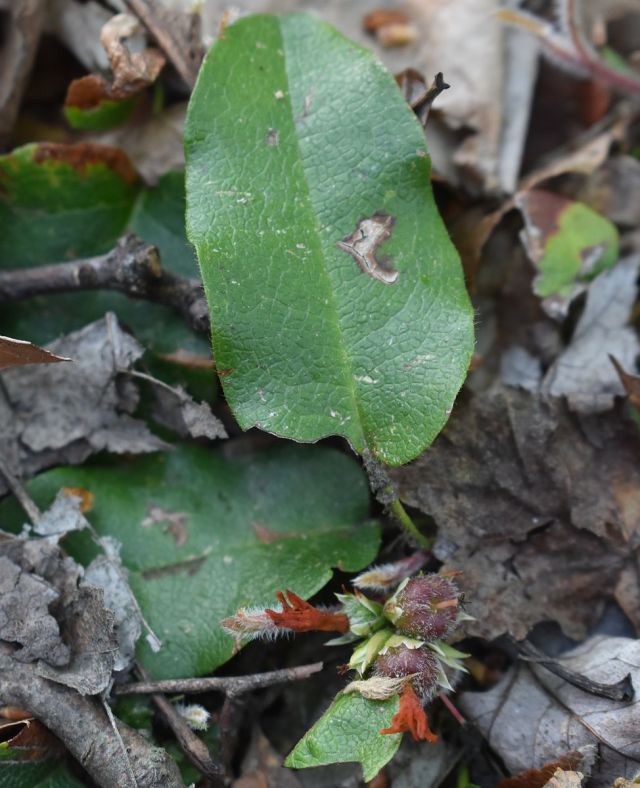
Trailing Arbutus (Epigaea repens) is an inconspicuous member of the Ericaceae family that sticks very close to the ground. Its leaves stay green through the winter. Very early in spring it has white flowers (note their orange-brown, already dried corollas from earlier in the spring!) which are now developing into berry-like capsules. According to Keith Clay, who published a paper on this in 1983, the seeds are ant-dispersed, but don’t feature elaiosomes typical of other ant-dispersed species. Instead, the seeds are embedded in the sweet, jelly-like placental tissue, which the ants gather and carry to their nest.
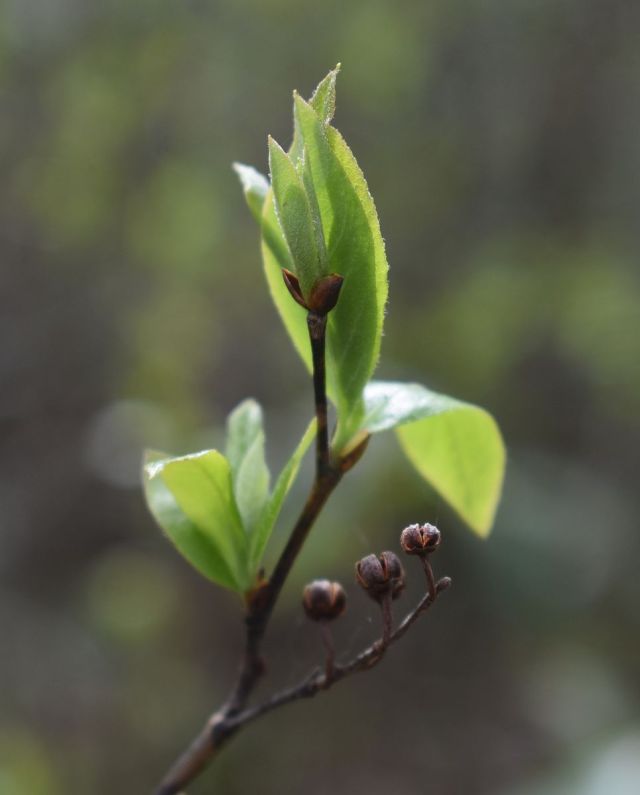
Maleberry (Lyonia ligustrina) is one of the shrubs in the Ericaceae family that produces dehiscent capsules instead of fleshy fruits. This image shows the seed capsules from last year, which had split open with five slits to release the seeds.
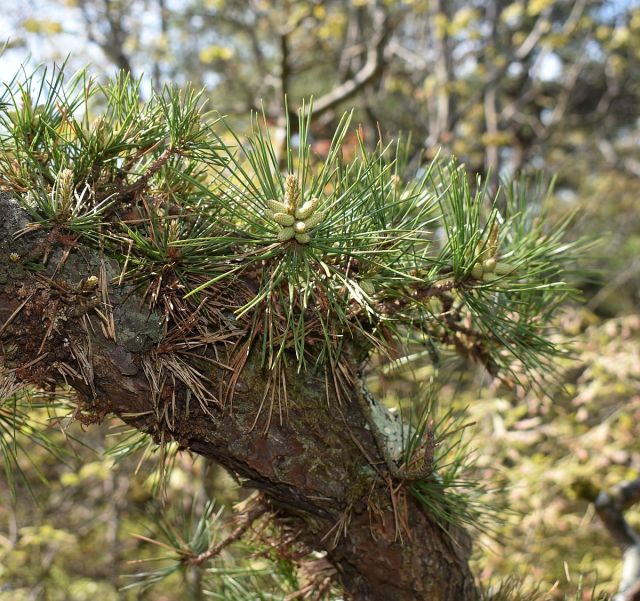
Pitch Pine (Pinus rigida) mixes with small oaks along the Taconic Ridge. Its needles grow in bundles of three while the more common White Pine (Pinus strobus) has five needles per bundle. Short branches growing right out of the bark are often seen in Pitch Pine.
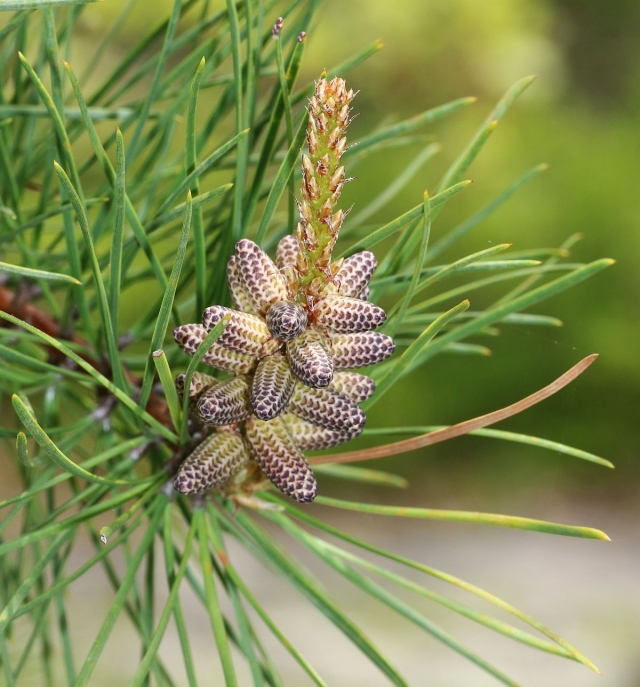
A close-up image of the pollen cones of Pitch Pine. Pines are monoecious, with seed cones and pollen cones growing on the same plant.

Oaks of three species occur along the ridge: stunted Red Oak (Quercus rubra) and White Oak (Quercus alba), which in more favorable conditions would grow into tall trees, are found together with the pictured Scrub Oak (Quercus ilicifolia), which stays shrubby and low and therefore presents its flowers and acorns at eye level. This image shows young acorns that are developing from last year’s female flowers and will be ripe this autumn. Above them on the new growth are this year’s pollen (male) catkins and this year’s tiny reddish female flowers, which—if pollinated—will take two years to mature into acorns.
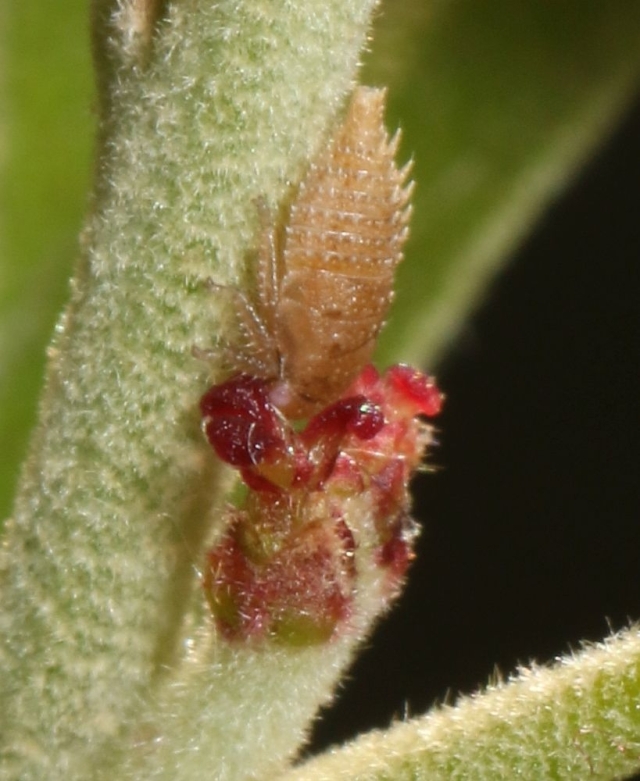
A close-up image of the female flower of Scrub Oak being visited by the nymph of a treehopper. We’re not sure if this was anything more than a casual visit.
This serves as the segue to the entomological portion of the program, so if you need an intermission, now’s your chance!
Not surprisingly, the diversity of herbivorous insects we saw along the ridge mirrored the plant composition described above. Oaks harbor a great number of insects, and we saw several Lepidoptera whose caterpillars are oak feeders.
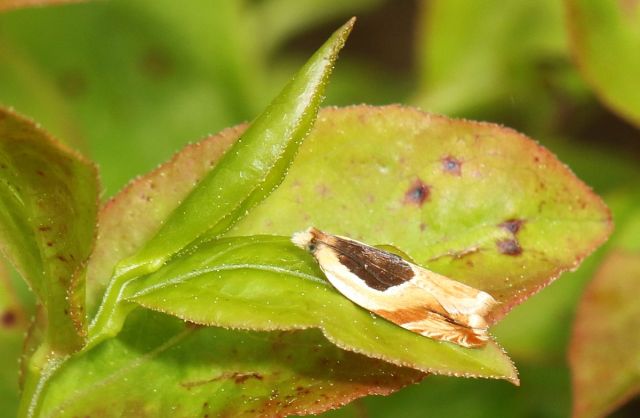
For example, this elegant moth is known as the Oak Leaffolder Moth or Ancylis burgessiana. As the name implies, its caterpillars are known to feed on oaks and, in addition, on chestnut and cherries, both of which were also present on the ridge. It occurs in eastern North America, and presumably, given the behavior of related species, its caterpillars fold leaves to protect themselves while feeding on shallow layers of leaf tissue.
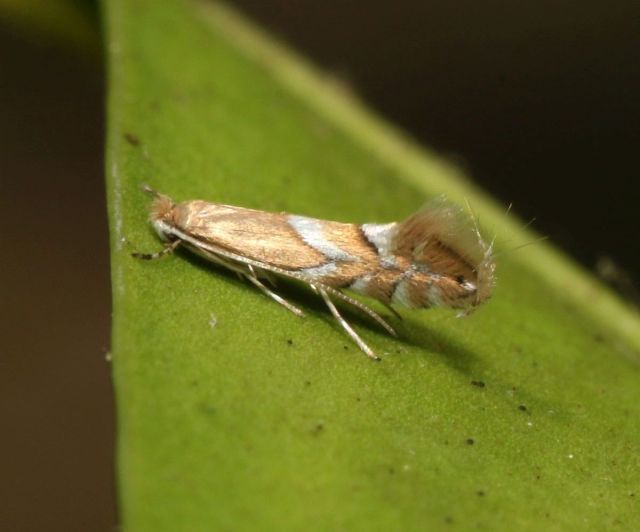
Similarly, Phyllonorycter aeriferella is another Eastern oak eater (no other hosts seem to be reported). Unlike the leafroller, the caterpillar of this moth protects itself by feeding in between the leaf cuticles, where it seems to cause a rather blotchy leaf mine.
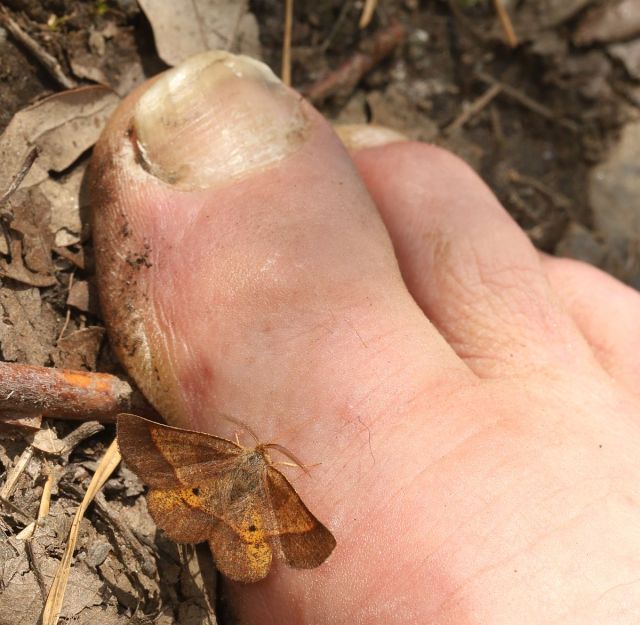
This beauty, here apparently attracted to skin salts on one of our feet (one takes the shots one gets!), is the Yellow-washed Metarranthis, Metarranthis obfirmaria. It has a similar distribution as the first two moth species and its caterpillars shouldn’t be short of food: they feed on oaks, Vaccinium and cherries.
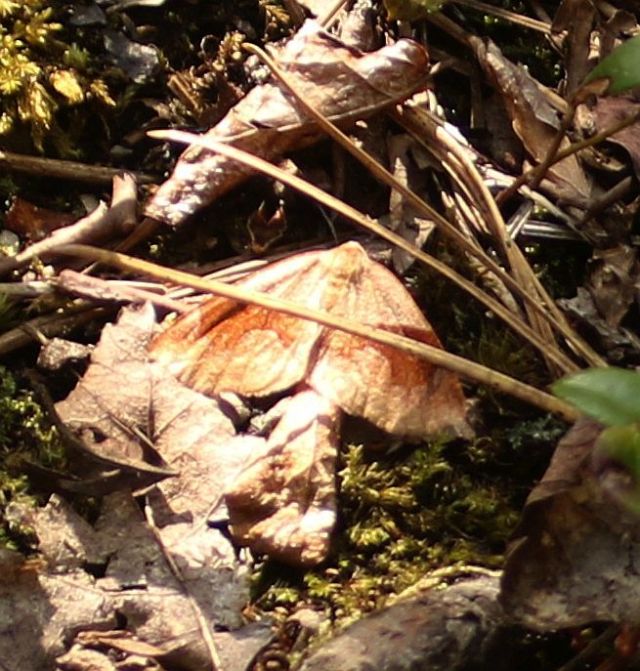
The biggest moth which we saw (and it wasn’t very big) was American Barred Umber, Plagodis pulveraria. The caterpillars of this widespread North American species were probably feeding on the leaves of the Grey, White and Black Birch scattered along the ridge.
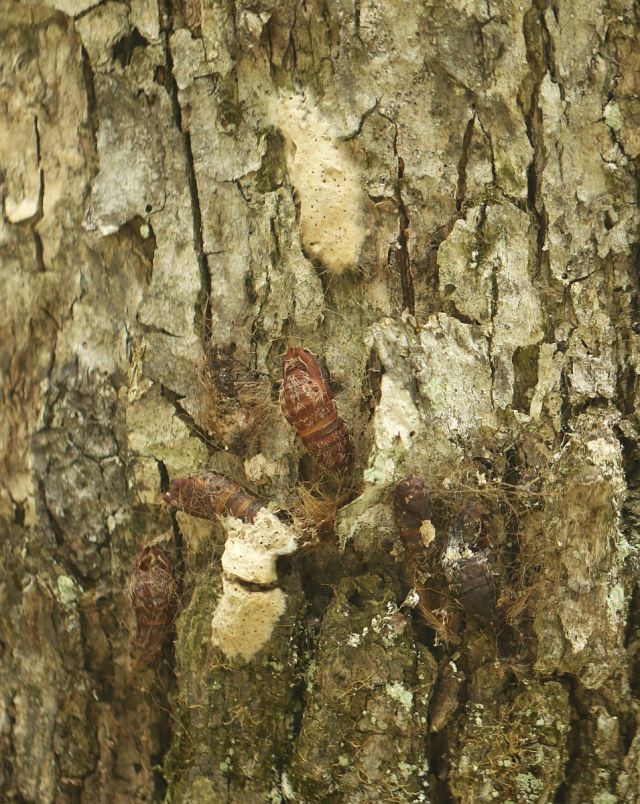
Finally in terms of moths, tree trunks were scattered with the remains of last year’s Spongy Moth (formerly Gypsy Moth) pupae and egg masses. Because the females are wingless, this egg mass might be from a mother who emerged from one of the nearby pupae. The pinholes in the egg mass indicate that the young have already emerged…

The young caterpillars were plentiful and seemed to be having no trouble finding food.
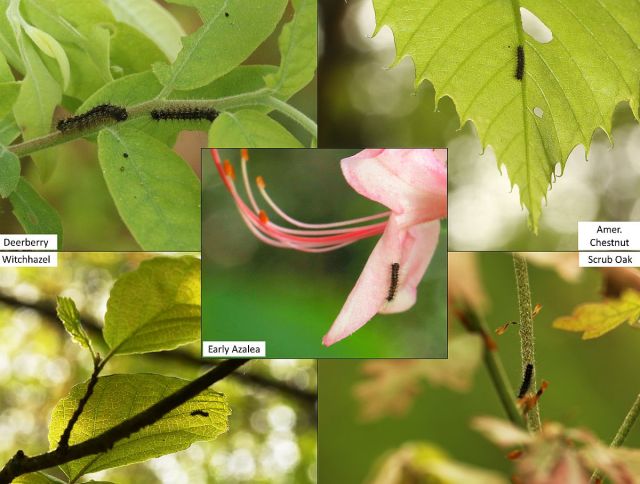
We saw them on Oak, Vaccinium, Witchhazel, American Chestnut, and Azalea, amongst other species. Maples seem to be largely, although not entirely, avoided.
While butterflies weren’t overly abundant, our ridgeline species were well-represented and, again, reflected the surrounding vegetation.
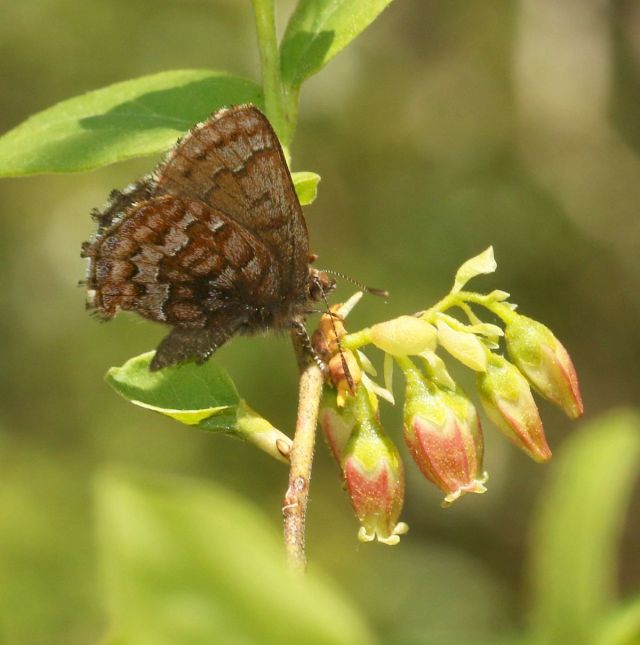
The Eastern Pine Elfin is a small, dancing butterfly and, so far as we know, our only regional butterfly whose caterpillars feed on pine. Along the ridge, their caterpillars were presumably feeding on the Pitch Pines pictured earlier.
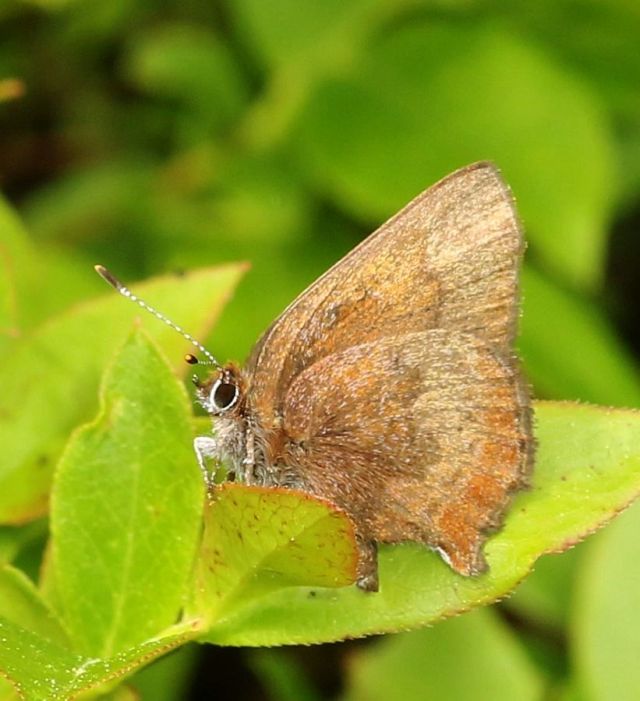
Its close relative, the Brown Elfin, was also on the wing. This is as close as we get to a butterfly which looks (due to color, not texture) as if it’s made out of leather. Its caterpillars are probably feeding on one or more of the ericaceous plants that have already been described. In our area, this species seems more restricted in its occurrence than the Pine Elfin, and we have only found it on rocky, open Taconic ridgetops. Brown Elfin has an interesting, split distribution, occurring in the eastern and western thirds of the country, but not through the central plains.
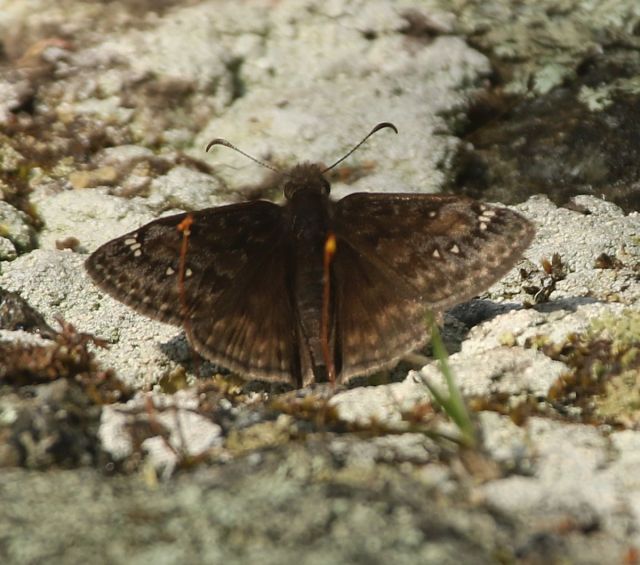
The most abundant butterfly was probably Juvenal’s Duskywing. This is one of our so-called “skippers”, presumably so named, because they skip about with a darting, hurried flight. One can get tired just watching a tattered male duskywing defend his territory against all winged passersby.
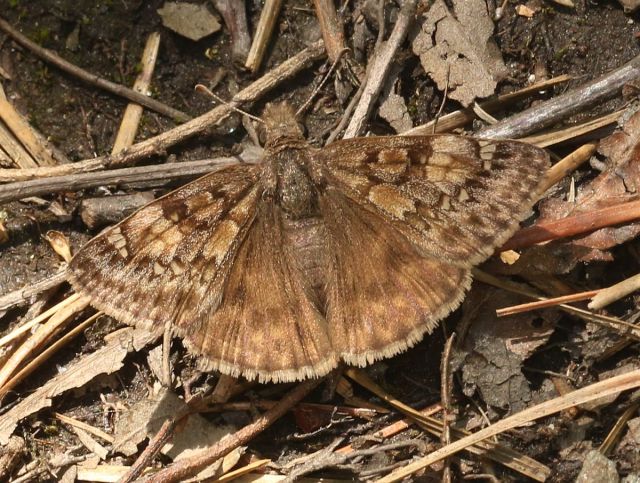
While their coloration is muted, the male (pictured previously) and female (shown here) are distinct, with females markedly more patterned than males. The caterpillars of the Juvenal’s Duskwing feed primarily on oaks and, as one might expect given the broad distribution of oaks in our landscape, they can be found from hilltop to valley.
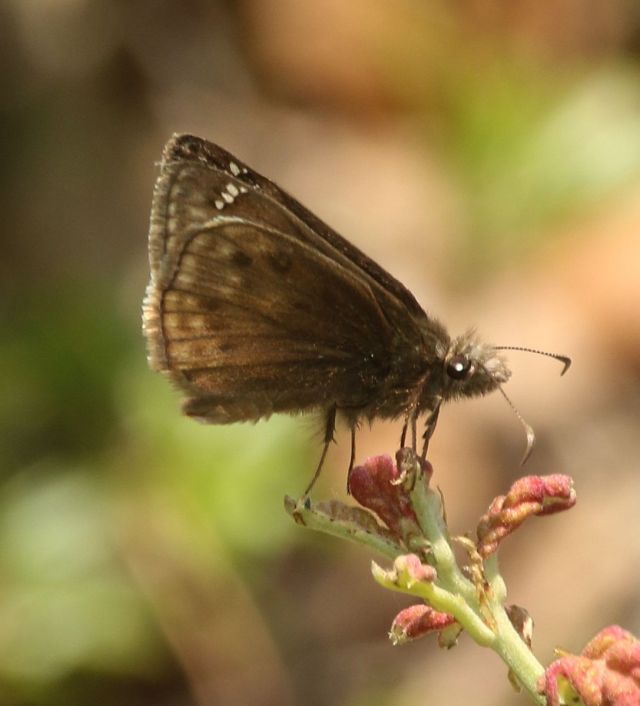
Determining that a duskywing is a duskywing is easy (a dark mottled skipper that holds its wings flat), but distinguishing amongst the species in the field seems like it is as much art as science.
So… we’re going out on a limb here when we claim we also saw a second duskywing species, Horace’s Duskywing, along the ridge. In appearance and habits (also an eastern oak eater), Horace’s is very similar to Juvenal’s. We’re proposing Horace’s here because the hind underwing lacks conspicuous white spots and the face seems lighter than in some of the Juvenal’s we’ve seen. That said, each of those traits is variable and none of the experts we consulted felt confident with this ID – dissection of the genitalia seems to be the defining trait. We’re not planning to undertake that, but there is another trick – the Juvenal’s Duskywing apparently has only one, springtime generation per year, whereas Horace’s also has a later flight. So, if we go back to Sunset Rock later in the summer and see a Juvenal’s Duskywing, then it’s probably actually a Horace’s Duskywing… Isn’t entomology fun?
We’ll round up this blog with a brief foray into the Hymenoptera (ants, bees, wasps). Bees were occasional – loud queen bumblebees searching for nesting sites, trim Nomada (see Aronia photo earlier) seeking nectar and the nests of other bees to parasitize, and the occasional carpenter bee out for a buzz.
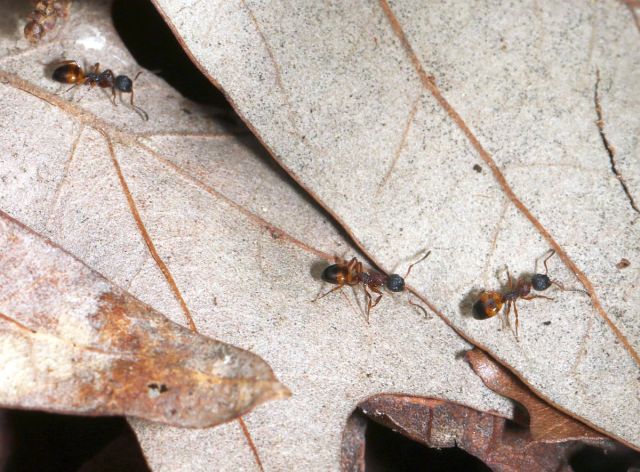
Ants seemed more forthcoming than bees with several species out and about. This attractively colored species is probably Dolichoderus plagiatus, the Mottled Dolichoderus. It is apparently a relatively common species of drier areas. It is said to have relatively small colonies (fewer than 100 workers) and to forage solo. However, as the photo attests, this group was on the move together.
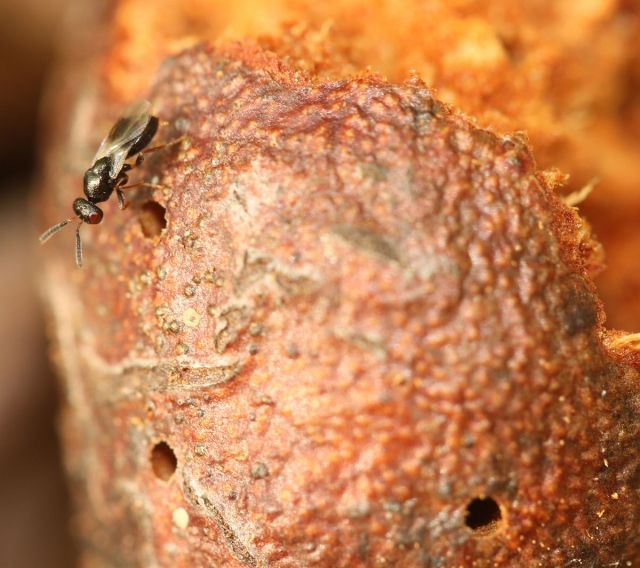
Lastly, what actually led us to notice the ants was a prominent woody gall protruding out of the ground. It had apparently afflicted the stem of some plant which had since died. The surface of the gall was dotted with tiny holes, presumably where the gall maker (or its parasites) had recently emerged. Several small wasps seemed interested in the gall, periodically landing on it and wandering over it. What their connection to the gall was, we don’t know. According to Kenny (our in-house wasp expert) these could be members of a gall making species or they could be the parasite of a gall making species. Or, they could just be passing gall fans. As with almost everything in natural history, MOA : “more observation advisable”!

Hooray for the large whorled pogonia!
LikeLike
Thank you for sharing this adventure for those who could not attend!
LikeLike